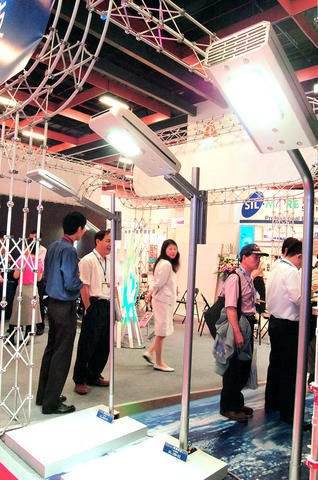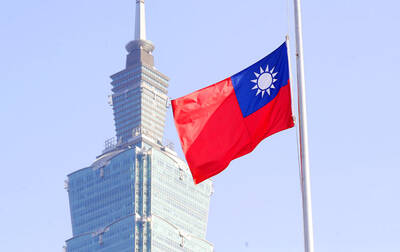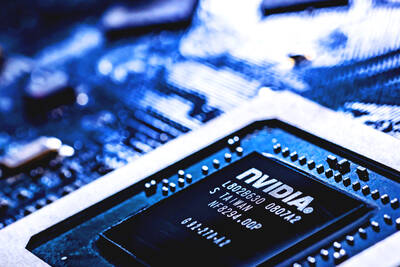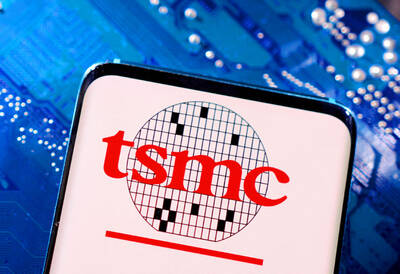Wellypower Optronics Corp (
The company will boost production capacity to as much as 12 million LEDs per month from 2 million currently, Tony Chang (張孜多), vice president of Wellypower, said on Friday.
The Hsinchu-based company last month raised its forecast for investment in LED production by 67 percent to NT$200 million (US$6 million) because of client requests for the diodes, he said.

PHOTO: WANG PEI-HUA, TAIPEI TIMES
The company will increase its capacity to produce LEDs 12-fold to 12 million pieces per month this year, he said.
Apple Inc last month introduced its first notebook using LEDs, and said the diodes will be used in new products because they contain less mercury and use less power. Wellypower, which makes fluorescent tubes that illuminate screens, will phase out production of smaller tubes within two years, Chang said.
"It's a long-term issue and now is the best time to enter the LED business," Chang said. "Customers are asking for more LEDs, so we are cutting back tubes for smaller displays."
LEDs are semiconductors that emit light whose color varies according to the component chemicals. Current backlights, which sit behind a liquid-crystal display, use fluorescent tubes, which burn more power and provide less color spectrum.
Shipments of LEDs used as backlights in screens larger than 10 inches will almost triple next year, compared with 12.8 percent growth for fluorescent tubes, according Austin, Texas-based Display Search.
Wellypower's sales of LEDs, which are used in 95 percent of mobile phones and increasingly in laptops, will more than double next year, Chang said, without giving details.
LEDs will account for between 5 percent and 10 percent of sales this year, rising to as much as 20 percent next year, he said.
The company's first-quarter net income fell 49 percent to NT$147.6 million amid a slowdown in the flat-panel industry and falling prices of fluorescent tubes. Sales gained 22 percent to NT$1.3 billion.
LEDs started as the little red indicators on clock radios and are backlights in most cellphones. Now the LEDs are helping Apple and Sony Corp slim down computers and televisions and cut power usage.
Apple's MacBooks, released last month, are the first of the company's laptops to use LEDs, part of a goal to eliminate mercury from Apple products and become more power-efficient.
Sony released a TV with an LED backlight in 2005, while Sharp Corp and Fujitsu Ltd also make notebooks that use LEDs.
The Ministry of Economic Affairs said in April it would spend NT$2.1 billion to replace all of the country's traffic lights, which use traditional bulbs, with LEDs within three years, and will also convert 1.35 million street lamps.
"Apple is the trendsetter; now that they're using LEDs everyone else will follow," said Jordan Chen, who holds shares of Everlight Electronics Co (億光電子), Epistar Corp (晶元光電) and Opto Tech Corp (華凌光電) among the US$200 million he manages as chief investment officer at Invesco Taiwan Ltd (景順投信).
"LED stocks are benefiting from power efficiency and environment protection, and the trend will continue," Chen said.
While more power efficient, LEDs are as much as 50 percent more expensive than fluorescent lights, limiting them at present to high-end notebooks where price is less of an issue, Chang said.
There is also widespread litigation. On May 9, the US International Trade Commission found Epistar infringed two patents owned by Lumileds Lighting International BV, a unit of Royal Philips Electronics NV.
The commission banned imports into the US of some of its chips, Epistar said in a press release.
Nichia Corp in April last year settled out of court a lawsuit filed in 2005 against Epistar and Everlight in Tokyo District Court to stop the Taiwanese firms from selling some of its products in Japan.
Despite the hurdles, shares of manufacturers Citizen Holdings Co, Toyoda Gosei Co and Stanley Electric Co of Japan, as well as Epistar and Everlight have beaten global electronics stocks and their national stock indexes this year.
"In the short term, investors may see LED stocks as overvalued and could reduce holdings," said Kevin Yang (楊師銘), who manages NT$200 million at Paradigm Asset Management (華頓投信), including Epistar and Everlight. "In the long term, the industry has growth momentum. First it's notebooks, then it will be TVs."
Taiwanese and Japanese companies claim about two-thirds of the global market for LEDs, said Deutsche Bank AG.
Nichia is the leader, along with Toyoda Gosei, minority-owned by Toyota Motor Corp, and Durham, North Carolina-based Cree Inc.
"Current P/E ratios don't yet reflect next year's revenue growth," said Eric Wei (魏恆祥), who helps manage NT$7 billion at Fubon Securities Investment Trust Corp (富邦投信), including LED makers.
"Share prices have risen a lot, but this year is just the start," Wei said, adding that Fubon plans to hold onto its Epistar and Everlight shares and is looking for more LED investments.

ELECTRONICS BOOST: A predicted surge in exports would likely be driven by ICT products, exports of which have soared 84.7 percent from a year earlier, DBS said DBS Bank Ltd (星展銀行) yesterday raised its GDP growth forecast for Taiwan this year to 4 percent from 3 percent, citing robust demand for artificial intelligence (AI)-related exports and accelerated shipment activity, which are expected to offset potential headwinds from US tariffs. “Our GDP growth forecast for 2025 is revised up to 4 percent from 3 percent to reflect front-loaded exports and strong AI demand,” Singapore-based DBS senior economist Ma Tieying (馬鐵英) said in an online briefing. Taiwan’s second-quarter performance beat expectations, with GDP growth likely surpassing 5 percent, driven by a 34.1 percent year-on-year increase in exports, Ma said, citing government

UNIFYING OPPOSITION: Numerous companies have registered complaints over the potential levies, bringing together rival automakers in voicing their reservations US President Donald Trump is readying plans for industry-specific tariffs to kick in alongside his country-by-country duties in two weeks, ramping up his push to reshape the US’ standing in the global trading system by penalizing purchases from abroad. Administration officials could release details of Trump’s planned 50 percent duty on copper in the days before they are set to take effect on Friday next week, a person familiar with the matter said. That is the same date Trump’s “reciprocal” levies on products from more than 100 nations are slated to begin. Trump on Tuesday said that he is likely to impose tariffs

HELPING HAND: Approving the sale of H20s could give China the edge it needs to capture market share and become the global standard, a US representative said The US President Donald Trump administration’s decision allowing Nvidia Corp to resume shipments of its H20 artificial intelligence (AI) chips to China risks bolstering Beijing’s military capabilities and expanding its capacity to compete with the US, the head of the US House Select Committee on Strategic Competition Between the United States and the Chinese Communist Party said. “The H20, which is a cost-effective and powerful AI inference chip, far surpasses China’s indigenous capability and would therefore provide a substantial increase to China’s AI development,” committee chairman John Moolenaar, a Michigan Republican, said on Friday in a letter to US Secretary of

Taiwan Semiconductor Manufacturing Co’s (TSMC, 台積電) market value closed above US$1 trillion for the first time in Taipei last week, with a raised sales forecast driven by robust artificial intelligence (AI) demand. TSMC saw its Taiwanese shares climb to a record high on Friday, a near 50 percent rise from an April low. That has made it the first Asian stock worth more than US$1 trillion, since PetroChina Co (中國石油天然氣) briefly reached the milestone in 2007. As investors turned calm after their aggressive buying on Friday, amid optimism over the chipmaker’s business outlook, TSMC lost 0.43 percent to close at NT$1,150